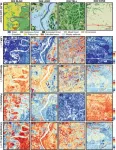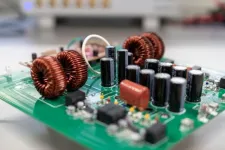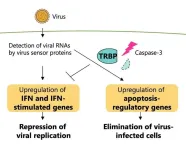(Press-News.org) An international team of researchers, led by Professor Jin WU from the School of Biological Sciences at The University of Hong Kong (HKU), has made a promising advancement in mapping plant functional traits from space using time-series satellite data. The study, published in Remote Sensing of Environment, showcases the innovative combination of the Sentinel-2 satellite mission and its dynamic time-series capabilities. This innovative approach not only unlocks a deeper understanding of essential foliar traits, providing crucial insights into the functional diversity and ecosystem functioning of terrestrial ecosystems, but it also equips us with powerful tools to address pressing environmental challenges effectively.
Leveraging the Satellites for In-depth Observations
Plant traits are vital in regulating key ecosystem processes such as carbon sequestration, air temperature regulation, and large-scale hydrological regulation. They also determine how ecosystems respond to various environmental stressors, ultimately determining their health, resilience, and vulnerability to climate change. However, large-scale mapping of these traits has been challenging due to limitations in existing methodologies, such as the difficulty in capturing traits across vast areas and issues such as data availability, trait complexity, and measurement techniques.
To overcome these challenges, Professor Wu’s team harnessed the power of satellite technology and introduced a pioneering approach that combines vegetation spectroscopy and phenology. Their approach utilised high-resolution imagery from the Sentinel-2 satellite, which captured multispectral data on a weekly interval with a 10-metre resolution. By analysing these satellite images, the team observed and recorded the reflections of light from plant leaves, providing valuable insights into the physical and biochemical properties of the vegetation. These observations were then compared to the timing of plant life cycle events, known as phenology. By integrating the data from satellite imagery and phenological observations, the team has been able to obtain comprehensive information about plant functional traits across high dimensions. This integration holds great potential for extending to other dimensions of plant characteristics, such as plant health, functioning, and resilience.
This method underwent thorough and rigorous testing to evaluate its efficacy, applicability across different scales, and potential for high-throughput monitoring. The test utilised benchmark data of 12 foliar traits collected from 14 geographically distant sites within the National Ecological Observatory Network (NEON) in the eastern United States.
Shuwen LIU, the first author and a PhD candidate from Professor Wu’s lab, stated: "Our approach effectively captures the diversity of plant traits at fine spatial scales while maintaining accuracy over large areas." Liu further explained that their method overcomes the limitations of other methods that rely solely on plant functional types or single image acquisitions.
The proposed approach outperformed traditional methods that rely on environmental variables or single Sentinel-2 images as predictors without requiring environmental variables to enhance predictive capabilities. This finding underscores the significance of phenological information in trait prediction and suggests that the ‘leaf economics spectrum’ theory may be the underlying mechanism driving their technical success. Given the model's proven effectiveness in 14 diverse ecosystem sites across the United States, it shows great promise for expansion to national and global scales, thereby enabling the monitoring of plant functional traits from ecosystem to regional and national levels.
Reflecting on the future potential of this research, Professor Wu said: "Future studies will focus on broader validation to fully exploit this technology’s potential in frontier basic science, such as understanding terrestrial ecosystems’ sensitivity response to climate change and identifying their respective tipping points. Additionally, there is great potential for applied science, particularly in exploring nature-based climate solutions."
About the research team
The Global Ecology and Remote Sensing (GEARS) lab at HKU aims to uncover the fundamental mechanisms that regulate vegetation-climate interactions across various scales, ranging from leaves to the global level. It employs a diverse range of tools, including cutting-edge geospatial techniques, field observations, eco-evolutionary and ecophysiological theories, earth system models, and high-performance computing. Its research goals are twofold: firstly, to advance fundamental science by exploring the mechanisms that link climate, species (functional) composition, and ecosystem processes, and secondly, to bridge the gap between scientific and technological advancements in order to address pressing environmental issues related to climate change, such as forest health monitoring, food security, climate change impact assessments, and nature-based climate change mitigation. About GEARS: https://wu-jin.weebly.com/
About Professor Jin Wu
Jin Wu is an Assistant Professor at HKU School of Biological Sciences and a recipient of the NSFC-Excellent Young Scholar (Hong Kong & Macau) award in 2019. Prior to this, he held a Goldhaber Distinguished Fellow position at Brookhaven National Laboratory and earned his PhD from the University of Arizona. With a wide range of interests in biodiversity, conservation, global change, and sustainability sciences, he utilises an integrated approach (combining remote sensing, AI, and domain knowledge) to study these topics and aims to enhance how people experience, understand, and appreciate our living habitats and inspire actions to sustain our natural ecosystems. He has published over 100 peer-reviewed papers, including in prestigious journals such as Science, Nature, Global Change Biology, and Remote Sensing of Environment. Currently, he serves as an Associate Editor for Remote Sensing in Ecology and Conservation.
Link to the paper and key figure:
The journal paper, entitled ‘Spectra-phenology integration for high-resolution, accurate, and scalable mapping of foliar functional traits using time-series Sentinel-2 data’, can be found at the following link: https://doi.org/10.1016/j.rse.2024.114082
For media enquiries, please contact Ms Casey To, External Relations Officer (tel: 3917 4948; email: caseyto@hku.hk / Ms Cindy Chan, Assistant Director of Communications of HKU Faculty of Science (tel: 3917 5286; email: cindycst@hku.hk).
END
Mapping plant functional diversity from space: HKU ecologists revolutionize ecosystem monitoring with novel field-satellite integration
2024-04-19
ELSE PRESS RELEASES FROM THIS DATE:
Lightweight and flexible yet strong? Versatile fibers with dramatically improved energy storage capacity
2024-04-19
The latest wearable devices, such as Samsung's Galaxy Ring and Apple's Vision Pro, are taking healthcare a step further and even enabling people to work virtually. Given the characteristics of wearable devices that require them to be small and lightweight, there is an inevitable limitation on battery capacity, still presenting a technical barrier to incorporating a variety of functions. In order for wearable devices to fully realize the imagined life, it is necessary to develop a lighter and more fromlessenergy storage method.
The Korea Institute of Science and Technology (KIST) announced that a joint research team led by Dr. Hyeonsu Jeong ...
3 ways to improve diabetes care through telehealth
2024-04-19
Grocery stores, airports and beaches aren’t great places to have telehealth visits with your endocrinologist. But home can be one of the best locations, giving a doctor helpful insights into a patient’s home environment, which can positively impact their care.
This is just one finding shared in a new study published this week in The Journal of Clinical Diabetes.
Researchers interviewed clinicians and staff who provide diabetes care through telehealth across four University of California academic medical ...
A flexible and efficient DC power converter for sustainable-energy microgrids
2024-04-19
A new DC-DC power converter is superior to previous designs and paves the way for more efficient, reliable and sustainable energy storage and conversion solutions. The Kobe University development can efficiently interface with a wide range of energy sources while enhancing system stability and simplicity at an unprecedented efficiency.
Electric power comes in two kinds, AC (alternating current) and DC (direct current). Famously, the question over which kind should be used for national power grids, the “Current War” of the late 19th century, got settled in favor of AC and most power plants today produce ...
Key protein regulates immune response to viruses in mammal cells
2024-04-19
Researchers have revealed the regulatory mechanism of a specific protein that plays a key role in balancing the immune response triggered by viral infections in mammal cells. These findings could help drive the development of antiviral therapies and nucleic acid medicines to treat genetic disorders.
For cells to protect themselves from viral infections, a series of immune responses typically occur, including programmed cell death called apoptosis and interferon signaling. While apoptosis is a normal process, which occurs with or without the presence ...
Development of organic semiconductors featuring ultrafast electrons
2024-04-19
Professors Kimoon Kim and Ji Hoon Shim along with Dr. Yeonsang Lee from the Department of Chemistry at Pohang University of Science and Technology (POSTECH) and Professor Jun Sung Kim from POSTECH’s Department of Physics and the Center for Artificial Low Dimensional Electronic Systems at the Institute for Basic Science created conducting two-dimensional polymers exhibiting electron mobility comparable to graphene. Their research has been featured in the online edition of Chem, an international chemistry journal.
Graphene, called a ...
Cancer is a disease of aging, but studies of older adults sorely lacking
2024-04-19
A systemic review of the current body of research shows that investigators have inadequately addressed the intersection of aging, health disparities, and cancer outcomes among older adults. This is the conclusion of a new paper published in the Journal of the American Geriatrics Society, and led by Nikesha Gilmore, PhD, a member of Wilmot Cancer Institute at the University of Rochester.
As the population of survivors of cancer 65 and older will likely double in size during the next two decades, the review reveals an urgent need for ...
Dietary treatment more effective than medicines in IBS
2024-04-19
Dietary treatment is more effective than medications in irritable bowel syndrome (IBS). These are the findings of a study conducted at the University of Gothenburg. With dietary adjustments, more than seven out of ten patients had significantly reduced symptoms.
Irritable bowel syndrome (IBS) is a common diagnosis that causes abdominal pain, gas and abdominal bloating, diarrhea, and constipation, in various combinations and with varying degrees of severity.
Treatment often consists of dietary advice such as eating small and frequent meals and avoiding excessive intake of food triggers such as coffee, alcohol and fizzy drinks. Patients may also be given medications to improve specific ...
Silent flight edges closer to take off, according to new research
2024-04-19
The study, published today in Journal of Fluid Mechanics, reveals for the first time how noise is generated and propagated from these engines, technically known as boundary layer ingesting (BLI) ducted fans. BLI ducted fans are similar to the large engines found in modern airplanes but are partially embedded into the plane's main body instead of under the wings. As they ingest air from both the front and from the surface of the airframe, they don't have to work as hard to move the plane, so it burns ...
Why can zebrafish regenerate damaged heart tissue, while other fish species cannot?
2024-04-19
A heart attack will leave a permanent scar on a human heart, yet other animals, including some fish and amphibians, can clear cardiac scar tissue and regrow damaged muscle as adults.
Scientists have sought to figure out how special power works in hopes of advancing medical treatments for human cardiac patients, but the great physiological differences between fish and mammals make such inquiries difficult.
So University of Utah biologists, led by assistant professor Jamie Gagnon, tackled the problem ...
Keck School of Medicine of USC orthopaedic surgery chair elected as 2024 AAAS fellow
2024-04-19
The American Association for the Advancement of Science (AAAS) has elected surgeon-researcher Jay Lieberman, MD, chair and professor of orthopaedic surgery at the Keck School of Medicine of USC, among its class of 2024 fellows.
The AAAS is the world’s oldest and largest general science organization and the publisher of Science, a top peer-reviewed academic journal. Election as a fellow is a lifetime honor — and one of the AAAS’s highest — signaling extraordinary achievement in the advancement or application of science.
Lieberman ...










